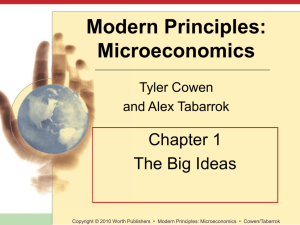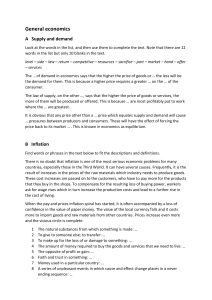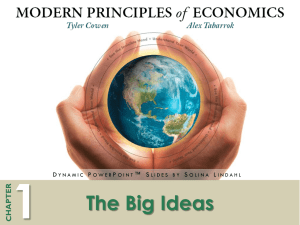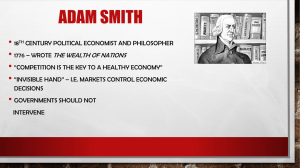Economics Big Ideas: Incentives, Trade-offs, and More
advertisement
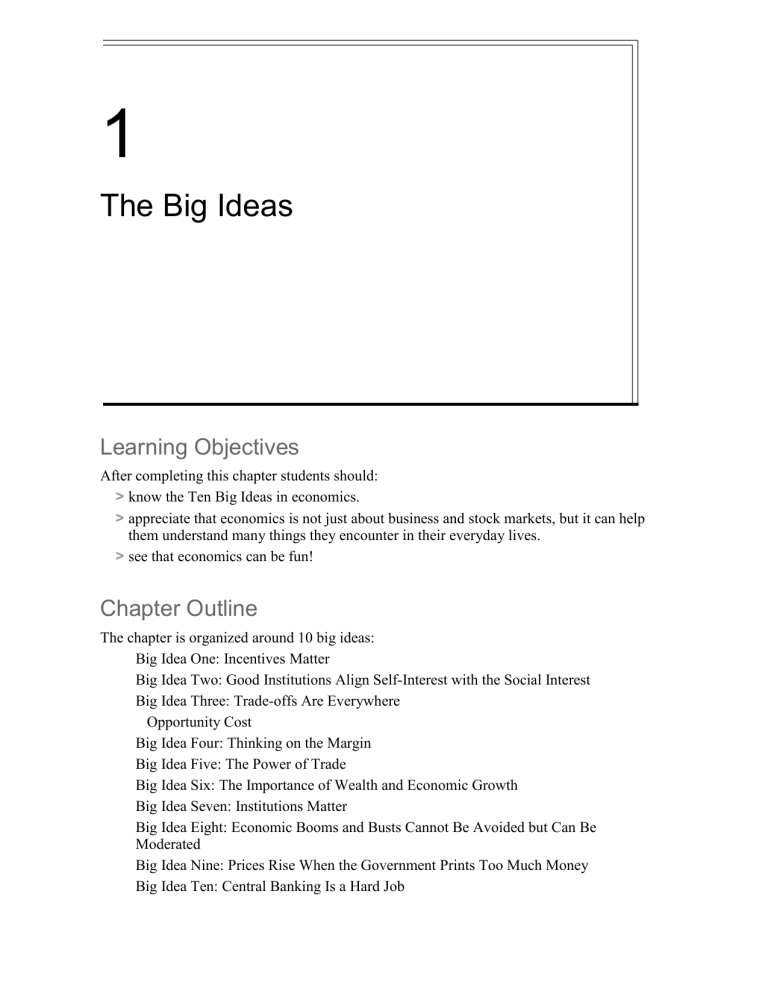
1 The Big Ideas Learning Objectives After completing this chapter students should: > know the Ten Big Ideas in economics. > appreciate that economics is not just about business and stock markets, but it can help them understand many things they encounter in their everyday lives. > see that economics can be fun! Chapter Outline The chapter is organized around 10 big ideas: Big Idea One: Incentives Matter Big Idea Two: Good Institutions Align Self-Interest with the Social Interest Big Idea Three: Trade-offs Are Everywhere Opportunity Cost Big Idea Four: Thinking on the Margin Big Idea Five: The Power of Trade Big Idea Six: The Importance of Wealth and Economic Growth Big Idea Seven: Institutions Matter Big Idea Eight: Economic Booms and Busts Cannot Be Avoided but Can Be Moderated Big Idea Nine: Prices Rise When the Government Prints Too Much Money Big Idea Ten: Central Banking Is a Hard Job CHAPTER 1 • The Big Ideas • 2 The Biggest Idea of All: Economics Is Fun Chapter Narrative This chapter briefly introduces 10 big ideas in economics that the students will learn more thoroughly in later chapters. Each big idea is explained, and then its importance is illustrated by showing how it explains some real-world phenomenon that the students should find interesting. The chapter aims to excite students about economics while giving them a quick introduction to the big ideas. The chapter opens by explaining how the British government rewarded ship captains for transporting convicts to Australia in the eighteenth century. At first, the captains were paid per convict who boarded the ship. The sailors treated the prisoners inhumanely, and their death rates were extraordinarily high. Then, when the government changed the payment system so that it paid captains according to how many prisoners walked off their ship in Australia, rather than how many walked on in England, suddenly the prisoners’ survival rate shot up to 99 percent. This illustration leads into the first big idea: incentives matter. Big Idea One: Incentives Matter Incentives are rewards and penalties that influence behavior. Changing the incentives changed how the captains treated their prisoners. Under the first payment system, there was no monetary reward for delivering the prisoners alive. In fact, if they didn’t feed the prisoners, the captains could sell the prisoners’ rations and earn even more money. Captains’ incentives were to treat prisoners poorly. Once they were paid according to how many healthy passengers they delivered, their incentives and thus their behavior changed for the better. Monetary rewards are one major incentive in our society. As Adam Smith said, “It is not from the benevolence of the butcher, the brewer, or the baker, that we expect our dinner, but from their regard to their own interest.” Teaching Tip: It’s easy to illustrate this idea to students quickly. Glance around the room and see who just recently purchased something, such as a Coke or coffee. Ask about the transaction. Who sold it? What was the seller’s name? Did the seller know the student’s name? Why was that product available there? What was the seller’s incentive? Emphasize the number of things that students need from people who have no incentive to help them other than the monetary reward. Not all incentives are monetary—fame, power, reputation, sex, and love are all important incentives. Emphasize that economics can explain things motivated by these incentives as well. Students should come away realizing that economics is not limited to explaining things that are paid for in money. Big Idea Two: Good Institutions Align Self-Interest with the Social Interest The story of how ships’ captains changed their behavior relates to the second big idea. Incentives are not fixed in stone. Different institutions or rules can engender different incentives and behaviors. An institution is good when it aligns an individual’s self- CHAPTER 1 • The Big Ideas • 3 interest with society’s interest. An institution is bad, and so are the outcomes, when individuals’ incentives run counter to society’s interest. Under the right conditions, markets align self-interest and social interest. It’s good that business people make money by pleasing consumers. Self-interest on their part can be good for society. Teaching Tip: Ask students if they ever worked overtime at a job. Why did they do it? Get them to explain that they wanted to earn the extra money. They were acting out of self-interest. But then emphasize how their self-interest made them provide more services to someone else than they would have otherwise. Be sure to point out that self-interest is not always good. Self-interest that is motivated by bad institutions is sometimes called greed. The captains’ greed was bad when institutions were bad. But that same desire for self-interest turned greed into a good thing when the institutions changed. Greed’s goodness (or usefulness) depends on the institutions. Markets with mutual voluntary interaction make self-interest useful most of the time. Of course, there are significant exceptions and one (such as pollution) could be pointed out to the students. Big Idea Three: Trade-offs Are Everywhere Students are first introduced to opportunity cost (without using that term) by the somewhat shocking conclusion that economists worry that pharmaceutical drugs could be too safe. In 2004, Merck withdrew the arthritis drug Vioxx from the market after a study showed that it could cause heart attacks and strokes. Yet the FDA had approved the drug five years earlier and millions had used it. Students will be tempted to conclude that the FDA should be more careful studying new drugs so that drugs like Vioxx never reach the market. Making drugs safer necessitates a trade-off: fewer companies will develop drugs because it would be more costly. This is known as drug loss. It will also take longer for good drugs to make it to market, causing people to miss out on the drug’s beneficial effect in the interim. This is known as drug lag. It takes an average of 12 years and $900 million to bring a new drug to market in the United States. The trade-off society faces for safer drugs is fewer drugs and getting them more slowly. This brings students to a key concept in economics: opportunity cost. The opportunity cost of a choice is the value of the opportunity lost because of that choice. Teaching Tip: Students are used to thinking of costs as monetary costs. Take some time to illustrate opportunity costs with examples that they can relate to. For example, what is the opportunity cost of going to a movie one night? How would that opportunity cost change if you had an exam the next day? The textbook provides another nice example: What is the cost of going to college? Tuition, books, lost wages, room and board. Ask students which of these is not an opportunity cost. Ask them if they considered lost wages when they decided to attend. Then explain why college enrollment is affected by the business cycle. Teaching Tip: You can have some fun with examples of opportunity cost by asking students questions that relate to everyday life. Try asking: CHAPTER 1 • The Big Ideas • 4 > In a social situation, have you ever walked up to two attractive people, looking for a date? You have to choose who to focus on. The opportunity cost of talking to the person you chose is loss of the opportunity to talk to the other person. (This leads nicely to the joke: an economist was asked how his wife was. He answered, “Compared to whom?”) > Does anyone play basketball? If you’re on a fast break and you pull up for a three-pointer, what is your opportunity cost? > If you weren’t here in my class today, what would you be doing? Keep drilling them with questions until they seem to get it. Big Idea Four: Thinking on the Margin Most choices are made on the margin. Should we do a little more of an activity or a little less? This concept is introduced in the book with a brief discussion of a driver making incremental changes to his speed as he travels down the highway. When he hasn’t seen a police cruiser in a while, he increases his speed a little more. When he finally spots one as he approaches a big city, he decreases his speed a little. Just like many decisions in life, the driver’s decision about his speed is not made once and for all upon starting his car. Rather, when it is beneficial to do so, he speeds up a little, until the benefits of speeding up a little no longer outweigh the costs (the increased likelihood of a ticket). Teaching Tip: Here is a fun illustration of marginal thinking from students’ everyday lives. Ask if they have ever chosen to go out with their friends instead of with their boyfriend or girlfriend and heard the objection, “You care more about them than you do me.” At least one hand will go up. Then explain that they now have an answer: “Not in an absolute sense. You are more important, but given that I already spend so much time with you, seeing them tonight is more important to me only on the margin.” Big Idea Five: The Power of Trade The benefits of trade go much further than the simple benefits of exchange. Through specialization, trade can increase productivity, and higher productivity leads to more output. One way that specialization increases productivity is through the division of knowledge. A producer who specializes in the production of just a few goods can become an expert in the production of those goods, learning things that would not have been learned if every person produced just a small amount of every good for his or her own use. Likewise, specialization allows producers to take advantage of economies of scale, the cost savings that can be achieved when goods are produced in higher quantities. The theory of comparative advantage maintains that everyone involved in specialization and trade can benefit from it. The key is for producers (or individuals or countries) to focus on producing at the lowest opportunity cost. The text uses the example of Martha Stewart, who although likely a very skilled ironer, hires someone to do her ironing. The reason? She is so productive at running her company (Martha Stewart Living Omnimedia) that if she spends an hour ironing, she gives up too much other production, and it is simply not worth it. CHAPTER 1 • The Big Ideas • 5 Big Idea Six: The Importance of Wealth and Economic Growth Some students will be tempted to discount the importance of wealth and economic growth because they associate it only with material standards of living. Now’s the time to drive home the point that increases in wealth give us more of many of the things we all value. A few quick examples from the text: > In 2007, more than half a billion people around the world contracted malaria, and about 1 million died of it. We think of it as a tropical disease, but people used to get it in the United States frequently until the 1940s. Better drainage, removal of mosquito breeding sites, and insecticides all contributed to wiping malaria out. We needed to grow wealthy enough to pay for these things before malaria could be eradicated. > In the United States, 993 in 1,000 children born survive until at least age five years. In Liberia, one of the world’s poorest countries, the survival rate is only 765 in 1,000. Most things people care about—like life expectancy, nutrition, and literacy—are all easier to get when you are wealthier. Big Idea Seven: Institutions Matter If wealth is so important, this naturally leads us to ask how to get wealth. This was the focus of much of Adam Smith’s seminal book An Inquiry into the Nature and Causes of the Wealth of Nations. Wealthy countries tend to have lots of physical and human capital and use them with the best technology available to produce goods and services more efficiently. But this still raises the question of why some countries have more than others and why they use it more efficiently. It all comes back to Big Idea One: Incentives Matter. Entrepreneurs, investors, and savers need the right incentives to save and invest in physical and human capital, innovation, and efficient organization. The institutions most important in supporting good incentives for these are property rights, political stability, honest government, a dependable legal system, and competitive and open markets. Teaching Tip: Ask the students how many of them came to college because they expect to earn more. How have the institutions in the United States given them the confidence to make that investment in their human capital? North Korea and South Korea provide a striking example of how different institutions affect wealth creation. The two countries have a common culture and geography and were equally poor in 1950. South Korea embraced property rights and markets, while North Korea did not. Today South Korea has more than 10 times the per capita income of North Korea. Teaching Tip: If you have access to the Internet in the classroom, pull up a satellite image of the Korean peninsula at night and show them the difference in light emissions between the two countries as an indicator of development. CHAPTER 1 • The Big Ideas • 6 Big Idea Eight: Economic Booms and Busts Cannot Be Avoided but Can Be Moderated Booms and busts are part of the normal response to changing economic conditions. Not all booms and busts are the same, though. The Great Depression was the worst economic downturn the United States has ever had. Output dropped by 30 percent, unemployment rose above 20 percent, and the stock market lost a third of its value. This was not a normal recession. Most economists believe that if the government had acted differently, the Depression would have been less severe. Monetary and fiscal policies affect the length and severity of economic booms and busts. At one time, economists believed that government policy could be used to end the economy’s boom and bust cycle. But most economists no longer believe that, and we’ve learned that when these policies are used poorly, they make recessions worse and the economy more volatile. Big Idea Nine: Prices Rise When the Government Prints Too Much Money Inflation is an increase in the general level of prices in an economy. Increases in the money supply cause inflation. Milton Friedman famously said, “Inflation is always and everywhere a monetary phenomenon.” Potential Pitfall: Although inflation comes from increases in the money supply, students are likely to think oil or greedy businessmen cause inflation. It’s worth stressing the monetary causes and how other factors influence relative prices but not the general level of prices. Inflation has negative consequences. Emphasize how inflation makes it hard to figure out the real value of goods and services. Most students in the United States have not experienced the chaos of serious inflation, whereas Zimbabwe recently had an inflation rate of over 531 billion percent. Money in that situation becomes virtually worthless and must be spent as soon as it’s earned, making organized trade harder. In Zimbabwe, people started buying things with prepaid cell phone minutes and gas cards instead of the national currency. Big Idea Ten: Central Banking Is a Hard Job The Federal Reserve controls monetary policy in the United States. But there is a lag— often months—from when the Fed makes a decision to when the effects of that decision are known. When it prints too much money, we get inflation. If it prints too little, we get falling prices. And often as prices and wages fall, the adjustment doesn’t go smoothly. But because of the lag, the Fed is always shooting at an unknown moving target. Most economists believe the Fed does more good than harm, but when the Fed does its difficult job poorly, it can cause great harm. Biggest Idea of All: Economics Is Fun The whole point of the first chapter, and your first lecture of the semester, is to excite students about economics. We need to show the students that: > economics is all around them in their daily lives. > economics is crucial for understanding the world and how to make it a better CHAPTER 1 • The Big Ideas • 7 place. > these principles of economics hold everywhere across the globe and through time. The motto of the book is “See the Invisible Hand. Understand Your World.” Chapter 1 and your lectures should arouse a desire in students to do that.


